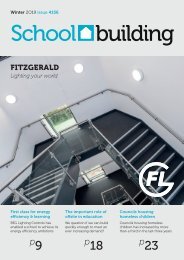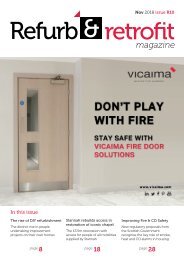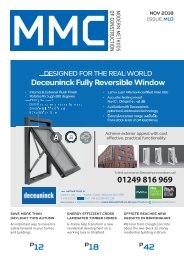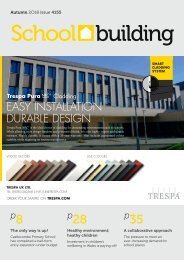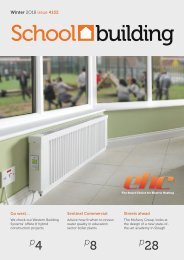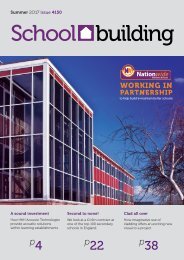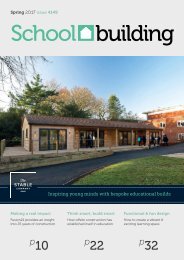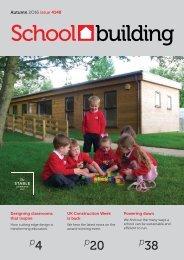a.aa MMC M11 52pp Web
You also want an ePaper? Increase the reach of your titles
YUMPU automatically turns print PDFs into web optimized ePapers that Google loves.
The design of an effective airtight system will<br />
reduce the risk of uncontrolled moisture<br />
movement, and the potential for damage caused<br />
by condensation within the building fabric.<br />
Effective airtightness design<br />
The two main ways to achieve airtightness in the<br />
building envelope are internally or externally, or in<br />
other terms, ‘inside of the services zone’ or ‘outside<br />
of the services zone’.<br />
Traditional use of internal air barriers can be more<br />
complex and costly to install, due to the need to<br />
accommodate building services such as electrical,<br />
lighting, heating and drainage systems. An internal<br />
air barrier is only as good as its installation. If all<br />
the service penetrations are not adequately<br />
sealed, performance will be compromised.<br />
For many years, external air barriers have been<br />
commonly specified in North American building<br />
design and construction. By moving the air barrier<br />
to the external side of the structural frame, external<br />
air barrier systems such as Wraptite from A.<br />
Proctor Group allow for an almost penetration-free<br />
airtight layer, which can be installed faster and<br />
more robustly. This offers an effective but simple<br />
system comprising a self-adhesive vapour<br />
permeable air barrier membrane, plus vapour<br />
permeable sealing tape, Wraptite Corners and<br />
Wraptite Liquid Flashing, and provides effective<br />
secondary weather protection while preventing<br />
trapped moisture and air leakage. Far simpler than<br />
internal options an external air barrier system like<br />
Wraptite will maintain the envelope’s integrity, with<br />
less building services and structural penetrations<br />
to be sealed, and less room for error.<br />
Incorporating Wraptite in the design makes sense<br />
Wraptite is a patented external air barrier<br />
membrane system, which offers manufacturers<br />
and designers of modular and off-site buildings<br />
the ability to reliably and comfortably exceed<br />
current airtightness requirements. Wraptite is the<br />
only self-adhering vapour permeable air barrier<br />
certified by the BBA and combines the important<br />
properties of vapour permeability and airtightness<br />
in one self-adhering membrane. This approach<br />
saves on both the labour and material costs<br />
associated with achieving the demands of energy<br />
efficiency in buildings.<br />
• Complies with use<br />
on buildings of high<br />
rise and over 18m<br />
under Part B<br />
amendments made<br />
in November 2018,<br />
Membranes need to<br />
be Class B,s3,d0 or<br />
better, with Wraptite<br />
at Class B,s1,d0*.<br />
• Included within<br />
BS8414 testing with<br />
cladding<br />
manufacturers.<br />
• EPDM not needed<br />
to the frame of the<br />
building as Wraptite<br />
is self-adhesive and<br />
continues across<br />
the whole envelope<br />
of the building<br />
against the<br />
sheathing board<br />
and the frame of the<br />
building.<br />
• Less EPDM around<br />
window details due<br />
to Wraptite lapping<br />
into the building at<br />
junctions.<br />
• Corner detailing for<br />
opening and<br />
movement joint<br />
interfaces are easily<br />
treated.<br />
• Improved<br />
airtightness and<br />
may negate the use of a VCL totally from the<br />
design internally, meaning easier a quicker<br />
install of dry lining package.<br />
• Hydro-Thermal Modelling (WUFI) showing the<br />
difference of not using a VCL within some<br />
constructions benefits the building further.<br />
• Improving airtightness may allow you to change<br />
thickness or type of insulation used when<br />
modelled through SAP or SBEM.<br />
• No need to tape sheathing boards as Wraptite<br />
is positioned across the whole board.<br />
Student<br />
Accommodation,<br />
Portsmouth<br />
Parker Tower,<br />
Covent Garden<br />
• Testing has seen<br />
results as low as 0.5<br />
m3/(h.m2) @ 50PA<br />
carried out at<br />
Windtech on a<br />
window façade<br />
panel.<br />
• By using Wraptite on<br />
the external, this may<br />
show you an<br />
improvement on<br />
making the building<br />
watertight, allowing<br />
your cladding<br />
package to come off<br />
the critical path and<br />
internal works to<br />
start earlier, and also<br />
internal works may<br />
not be installing a<br />
VCL so the site<br />
program is<br />
potentially quicker.<br />
High-performance off-site solutions<br />
The A. Proctor Group Ltd has been providing<br />
solutions and products to the construction<br />
industry for over 50 years. The company has<br />
been developing vapour permeable membranes<br />
and vapour control layers for over 25 years, and<br />
provides an extensive range of superior highperformance<br />
products suitable for modular and<br />
off-site construction.<br />
Dedicated in its approach to helping you to<br />
achieve best practice, effective and reliable<br />
solutions to meet your modular building<br />
requirements in line with building regulations and<br />
energy efficiency, the A. Proctor Group team of<br />
highly experienced industry professionals and<br />
technical advisors is on at hand to guide you and<br />
support you from design throughout the<br />
construction process.<br />
The A. Proctor Group range of products include<br />
unique off-site solutions for the following sectors:<br />
• Private and social/affordable housing<br />
• Purpose built student accommodation<br />
• Self-build projects<br />
• Hotels<br />
• Education buildings<br />
• Healthcare including hospitals, health centres<br />
and healthcare facilities<br />
*tested over 12mm calcium silicate board / fibre<br />
cement board as per BS EN 13238:2010. All<br />
tests carried out to EN 13859-2 standard.<br />
www.proctorgroup.com<br />
Feb 2019 <strong>M11</strong><br />
33





